#louise élisabeth de france
Text
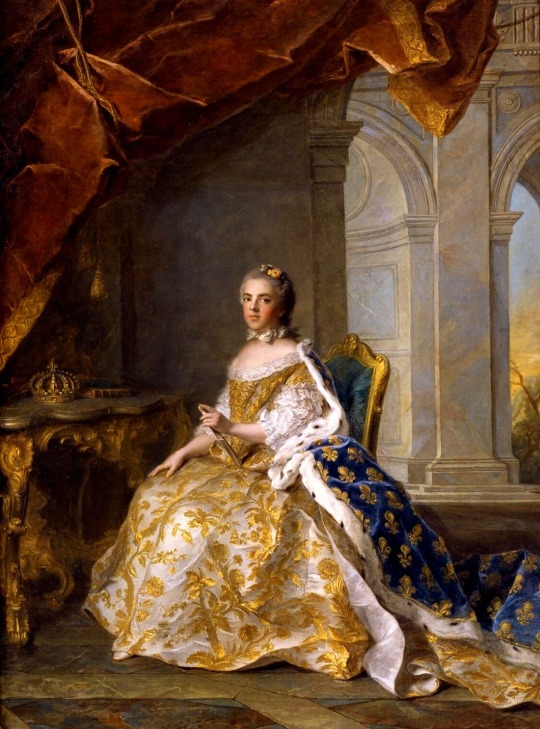
Portrait of Louise Elisabeth of France (1727-1759), Duchess of Parma, in court dress. By Jean-Marc Nattier.
#royaume de france#fille de france#maison de bourbon#louise élisabeth de france#duchese de parme#Madame Première#madame infante#princesse de france#jean marc nattier#court dress#kingdom of france#house of bourbon#regno d'italia#kingdom of italy#fils et filles de france#fils et filles de louis xv
10 notes
·
View notes
Text
"I am at present in undeserved disgrace."
As the examples of, among others, Marie de Medici, the duchesse de Longueville and the Grande Mademoiselle had demonstrated, the king's relationships with his closest female relatives was potentially as troublesome as that with any prince. After 1661, Louis XIV's principal concern was to uphold his own authority and to prevent the almost inevitable household disputes from threatening the tranquillity of his court. With so many men on active military service, Versailles during the later years of the reign was very much a feminine sphere, and disgrace was a no less constant preoccupation for aristocratic women who were determined to preserve their own personal and dynastic interests. Madame, duchesse d'Orléans, frequently returned to the theme. As a woman of trenchant and forthright views, she had struggled to remain in the king's good graces. In January 1691, she noted with pleasure that the king had paid some of her gambling debts, which she interpreted as a sign "that I am not so deeply in disgrace this year at last." Her good fortune proved short-lived, and many of her problems stemmed from her unguarded correspondence and her almost legendary hostility to the marquise de Maintenon. By September 1696, she could write venomously that:
"I am at present in undeserved disgrace. Whenever I come in the king's apartment the dirty old slut [Maintenon] withdraws and when I beg her to remain, she makes no reply but goes out with a sneer on her face. I am being treated in a very rude fashion. Every day I am forced to wait half-an-hour at the king's door before I am allowed to enter, and sometimes I am even sent away, although at the same time all the king's bastards and even Monsieur himself are in the room."
Some of her discomfiture on this and other occasions may have arisen from impatience with the dictates of protocol, but even if that was the case her sensitivity to every personal or ceremonial slight was typical of court society as a whole.
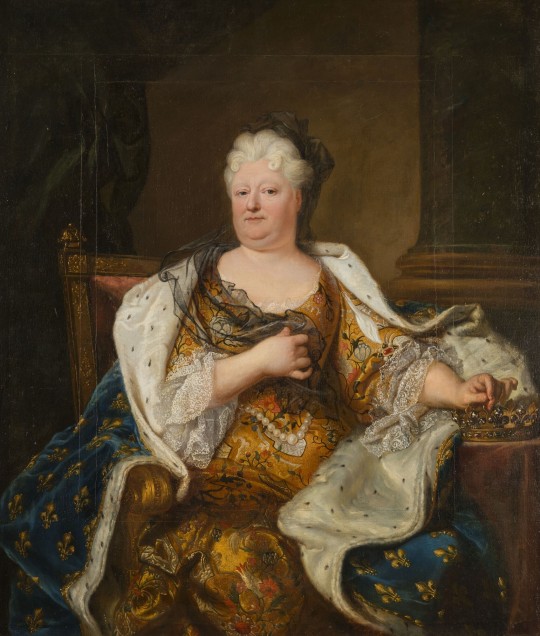
Julian Swann- Exile, inprisonment or death- The Politics of Disgrace in Bourbon France
#xvii#julian swann#exile inprisonment or death: the politics of disgrace in bourbon france#marie de médicis#anne geneviève de bourbon condé#madame de longueville#la grande mademoiselle#anne marie louise d'orléans#louis xiv#la princesse palatine#élisabeth charlotte du palatinat#madame de maintenon
18 notes
·
View notes
Text
Today's random fanfiction is from the L'Échange des princesses | The Royal Exchange (2017) fandom. Rien à voir. by AngelicaR2
Chapters: 1/1
Words: 336
Fandom: 18th Century CE RPF, L’Échange des princesses | The Royal Exchange (2017)
Rating: General Audiences
Warnings: No Archive Warnings Apply
Relationships: Mme de Ventadour & Marie Anne Victoire d'Espagne
Characters: Mme de Ventadour, Marie Anne Victoire d'Espagne, Louis XV de France, Louise-Élisabeth d'Orléans
Additional Tags: Spain, Versailles - Freeform, 18th Century, Drabble, Hope, Travel, differences
Language: Français
Summary: [L’Échange des princesses] : Drabble. “Marie Anne Victoire n'a rien à voir avec Louise-Elizabeth, et Mme de Ventadour espère sincèrement que cela ne va pas changer.”
#fic rec#random fanfiction#random#random recs#fanfic#ao3#fanfiction recommendation#fanfic rec#fanfiction#ao3 fanfic#18th Century CE RPF#L’Échange des princesses | The Royal Exchange (2017)#Mme de Ventadour & Marie Anne Victoire d'Espagne#Mme de Ventadour#Marie Anne Victoire d'Espagne#Louis XV de France#Louise-Élisabeth d'Orléans#Spain#Versailles - Freeform#18th Century#Drabble#Hope#Travel#differences
0 notes
Text
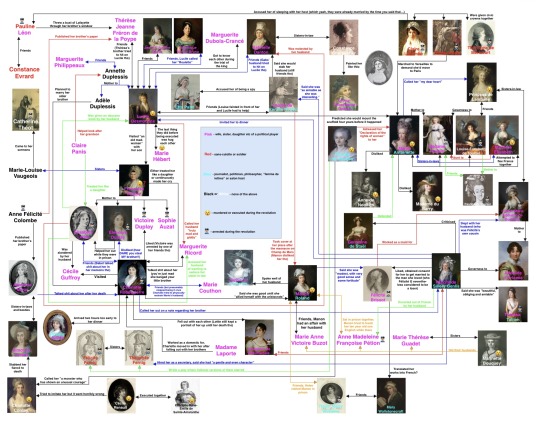
I decided to try this but for the girlies instead.
Are you sure want to click on ”keep reading”?
For Pauline Léon marrying Claire Lacombe’s host, see Liberty: the lives of six women in Revolutionary France (2006) by Lucy Moore, page 230
For Pauline Léon throwing a bust of Lafayette through Fréron’s window and being friends with Constance Evrard, see Pauline Léon, une républicaine révolutionnaire (2006) by Claude Guillon.
For Françoise Duplay’s sister visiting Catherine Théot, see Points de vue sur l’affaire Catherine Théot (1969) by Michel Eude, page 627.
For Anne Félicité Colombe publishing the papers of Marat and Fréron, see The women of Paris and their French Revolution (1998) by Dominique Godineau, page 382-383.
For the relationship between Simonne Evrard and Albertine Marat, see this post.
For Albertine Marat dissing Charlotte Robespierre, see F.V Raspail chez Albertine Marat (1911) by Albert Mathiez, page 663.
For Lucile Desmoulins predicting Marie-Antoinette would mount the scaffold, see the former’s diary from 1789.
For Lucile being friends with madame Boyer, Brune, Dubois-Crancé, Robert and Danton, calling madame Ricord’s husband ”brusque, coarse, truly mad, giddy, insane,” visiting ”an old madwoman” with madame Duplay’s son and being hit on by Danton as well as Louise Robert saying she would stab Danton, see Lucile’s diary 1792-1793.
For the relationship between Lucile Desmoulins and Marie Hébert, see this post.
For the relationship between Lucile Desmoulins and Thérèse Jeanne Fréron de la Poype, and the one between Annette Duplessis and Marguerite Philippeaux, see letters cited in Camille Desmoulins and his wife: passages from the history of the dantonists (1876) page 463-464 and 464-469.
For Adèle Duplessis having been engaged to Robespierre, see this letter from Annette Duplessis to Robespierre, seemingly written April 13 1794.
For Claire Panis helping look after Horace Desmoulins, see Panis précepteur d’Horace Desmoulins (1912) by Charles Valley.
For Élisabeth Lebas being slandered by Guffroy, molested by Danton, treated like a daughter by Claire Panis, accusing Ricord of seducing her sister-in-law and being helped out in prison by Éléonore, see Le conventionnel Le Bas : d'après des documents inédits et les mémoires de sa veuve, page 108, 125-126, 139 and 140-142.
For Élisabeth Lebas being given an obscene book by Desmoulins, see this post.
For Charlotte Robespierre dissing Joséphine, Éléonore Duplay, madame Genlis, Roland and Ricord, see Mémoires de Charlotte Robespierre sur ses deux frères (1834), page 76-77, 90-91, 96-97, 109-116 and 128-129.
For Charlotte Robespierre arriving two hours early to Rosalie Jullien’s dinner, see Journal d’une Bourgeoise pendant la Révolution 1791–1793, page 345.
For Charlotte Robespierre physically restraining Couthon, see this post.
For Charlotte Robespierre and Françoise Duplay’s relationship, see Mémoires de Charlotte Robespierre sur ses deux frères (1834) page 85-92 and Le conventional Le Bas: d’après des documents inédits et les mémoires de sa veuve (1902) page 104-105
For the relationship between Charlotte Robespierre and Victoire and Élisabeth Lebas, see this post.
For Charlotte Robespierre visiting madame Guffroy, moving in with madame Laporte and Victoire Duplay being arrested by one of Charlotte’s friends, see Charlotte Robespierre et ses amis (1961)
For Louise de Kéralio calling Etta Palm a spy, see Appel aux Françoises sur la régénération des mœurs et nécessité de l’influence des femmes dans un gouvernement libre (1791) by the latter.
For the relationship between Manon Roland and Louise de Kéralio Robert, see Mémoires de Madame Roland, volume 2, page 198-207
For the relationship between Madame Pétion and Manon Roland, see Mémoires de Madame Roland, volume 2, page 158 and 244-245 as well as Lettres de Madame Roland, volume 2, page 510.
For the relationship between Madame Roland and Madame Buzot, see Mémoires de Madame Roland (1793), volume 1, page 372, volume 2, page 167 as well as this letter from Manon to her husband dated September 9 1791. For the affair between Manon and Buzot, see this post.
For Manon Roland praising Condorcet, see Mémoires de Madame Roland, volume 2, page 14-15.
For the relationship between Manon Roland and Félicité Brissot, see Mémoires de Madame Roland, volume 1, page 360.
For the relationship between Helen Maria Williams and Manon Roland, see Memoirs of the Reign of Robespierre (1795), written by the former.
For the relationship between Mary Wollstonecraft and Helena Maria Williams, see Collected letters of Mary Wollstonecraft (1979), page 226.
For Constance Charpentier painting a portrait of Louise Sébastienne Danton, see Constance Charpentier: Peintre (1767-1849), page 74.
For Olympe de Gouges writing a play with fictional versions of the Fernig sisters, see L’Entrée de Dumourier à Bruxelles ou les Vivandiers (1793) page 94-97 and 105-110.
For Olympe de Gouges calling Charlotte Corday ”a monster who has shown an unusual courage,” see a letter from the former dated July 20 1793, cited on page 204 of Marie-Olympe de Gouges: une humaniste à la fin du XVIIIe siècle (2003) by Oliver Blanc.
For Olympe de Gouges adressing her declaration to Marie-Antoinette, see Les droits de la femme: à la reine (1791) written by the former.
For Germaine de Staël defending Marie-Antoinette, see Réflexions sur le procès de la Reine par une femme (1793) by the former.
For the friendship between Madame Royale and Pauline Tourzel, see Souvernirs de quarante ans: 1789-1830: récit d’une dame de Madame la Dauphine (1861) by the latter.
For Félicité Brissot possibly translating Mary Wollstonecraft, see Who translated into French and annotated Mary Wollstonecraft’s Vindication of the Rights of Woman? (2022) by Isabelle Bour.
For Félicité Brissot working as a maid for Louise Marie Adélaïde de Bourbon, see Mémoires inédites de Madame la comptesse de Genlis: sur le dix-huitième siècle et sur la révolution française, volume 4, page 106.
For Reine Audu, Claire Lacombe and Théroigne de Méricourt being given civic crowns together, see Gazette nationale ou le Moniteur universel, September 3, 1792.
For Reine Audu taking part in the women’s march on Versailles, see Reine Audu: les légendes des journées d’octobre (1917) by Marc de Villiers.
For Marie-Antoinette calling Lamballe ”my dear heart,” see Correspondance inédite de Marie Antoinette, page 197, 209 and 252.
For Marie-Antoinette disliking Madame du Barry, see https://plume-dhistoire.fr/marie-antoinette-contre-la-du-barry/
For Marie-Antoinette disliking Anne de Noailles, see Correspondance inédite de Marie Antoinette, page 30.
For Louise-Élisabeth Tourzel and Lamballe being friends, see Memoirs of the Duchess de Tourzel: Governess to the Children of France during the years 1789, 1790, 1791, 1792, 1793 and 1795 volume 2, page 257-258
For Félicité de Genlis being the mistress of Louise Marie Adélaïde de Bourbon’s husband, see La duchesse d’Orléans et Madame de Genlis (1913).
For Pétion escorting Madame Genlis out of France, see Mémoires inédites de Madame la comptesse de Genlis…, volume 4, page 99.
For the relationship between Félicité de Genlis and Louise de Kéralio Robert, see Mémoires de Madame de Genlis: en un volume, page 352-354
For the relationship between Félicité de Genlis and Germaine de Staël, see Mémoires inédits de Madame la comptesse de Genlis, volume 2, page 316-317
For the relationship between Félicité de Genlis and Théophile Fernig, see Mémoires inédits de Madame la comptesse de Genlis, volume 4, page 300-304
For the relationship between Félicité de Genlis and Félicité Brissot, see Mémoires inédites de Madame la comptesse de Genlis, volume 4, page 106-110, as well as this letter dated June 1783 from Félicité Brissot to Félicité Genlis.
For the relationship between Félicité de Genlis and Théresa Cabarrus, see Mémoires de Madame de Genlis: en un volume (1857) page 391.
For Félicité de Genlis inviting Lucile to dinner, see this letter from Sillery to Desmoulins dated March 3 1791.
For Marinette Bouquey hiding the husbands of madame Buzot, Pétion and Guadet, see Romances of the French Revolution (1909) by G. Lenotre, volume 2, page 304-323
Hey, don’t say I didn’t warn you!
#french revolution#frev#marie antoinette#pauline léon#claire lacombe#théroigne méricourt#reine audu#charlotte robespierre#éléonore duplay#élisabeth duplay#élisabeth lebas#lucile desmoulins#louise de kéralio#félicité de genlis#félicité brissot#mary wollstonecraft#manon roland#madame royale#charlotte corday#albertine marat#simonne evrard#catherine théot#madame élisabeth#sophie condorcet#françoise duplay#cécile renault#gabrielle danton#louise sebastien danton#theresa tallien#theresa cabarrus
184 notes
·
View notes
Text



















Historical Portraits of Children // The Truth is a Cave – The Oh Hellos
Four Children Making Music – attributed to the master of the Countess of Warwick, 1565 // Three Children with a Dog or Two Sisters and a Brother of the Artist – Sofonisba Anguissola, 1570-1590 // The Children of Philip III of Spain (Ferdinand, Alfonso, and Margarita) – Bartolomé González y Serrano, 1612 // Three Children with a Goat-Cart – Frans Hals, 1620 // The Balbi Children – Anthony van Dyck, 1625-1627 // The Three Eldest Children of Charles I – Anthony van Dyck, 1635-1636 // Five Eldest Children of Charles I – Anthony van Dyck, 1637 // Portrait of the Children of Habert de Montmor – Philippe de Champaigne, 1649 // Group Portrait of Charlotte Eleonora zu Dohna, Amalia Louisa zu Dohna, and Friedrich Christoph zu Dohna-Carwinden – Pieter Nason, 1667 // The Graham Children – William Hogarth, 1742 // Portrait of Sir Edward Walpole’s Children – Stephen Slaughter, 1747 // The Bateson Children – Strickland Lowry, 1762 // The Gower Family: The Five Youngest Children of the 2nd Earl Gower – George Romney, 1776-1777 // Marie-Antoinette de Lorraine-Habsbourg, Queen of France, and Her Children – Élisabeth Louise Vigée Le Brun, 1787 // The Marsham Children – Thomas Gainsborough, 1787 // The Oddie Children – William Beechey, 1789 // Three Siblings – Johann Nepomuk Mayer, 1846 // Happy Children – Paul Barthel, 1898 // My Children – Joaquín Sorolla, 1904 // The Truth is a Cave – The Oh Hellos
#this line makes me feel Very Normal and not at all Deranged 🥴😵💫#portraiture#family portrait#portrait#portrait painting#sofonisba anguissola#frans hals#anthony van dyck#philippe de champaigne#william hogarth#george romney#elisabeth vigee le brun#elisabeth louise vigee le brun#thomas gainsborough#joaquin sorolla#the truth is a cave#the truth is a cave song#the truth is a cave the oh hellos#through the deep dark valley#through the deep dark valley album#through the deep dark valley the oh hellos#the oh hellos#art history#art#lyrics#lyric art#long post
33 notes
·
View notes
Text
Collaborative Masterpost on Saint-Just
Primary Sources
Oeuvres complètes available online: Volume 1 and Volume 2
A few speeches
L'esprit de la révolution et de la constitution de la France (1791)
Transcription of the Fragments sur les institutions républicaines (1800) kept at the BNF by Pierre Palpant
Alain Liénard's edition and transcription of his works in Théorie politique (1976)
Some letters kept in Papiers inédits trouvés chez Robespierre, Saint-Just, Payan, etc. (1828)
Fragment autographe des Institutions républicaines
Une lettre autographe signée de Saint-Just, L. B. Guyton et Gillet (not his writing but still interesting)
Two files at the BNF with his writing (and other strange random stuff):
Notes et fragments autographes - NAF 24136
Fragments de manuscrits autographes, avec pièces annexes provenant de Bertrand Barère, de V. Expert et d'H. Carnot - NAF 24158
Albert Soboul's transcription of the Institutions républicaines + explanation of what's in these files at the BNF
Anne Quenneday's philological note on the manuscript by Saint Just, wrongly entitled De la Nature (NAF 12947)
Masterpost (inventory, anecdotes, etc.) - by obscurehistoricalinterests
Chronology
Chronology from Bernard Vinot's biography
Testimonies
Élisabeth Duplay-Le Bas on Saint-Just, as reported by David d'Angers - by frevandrest and robespapier
Élisabeth Duplay-Le Bas corrects Alphonse de Lamartine’s Histoire des girondins (1847) - by anotherhumaninthisworld
Many testimonies by contemporaries (in French) on antoine-saint-just.fr
Representations
Everything Wrong with Saint-Just's Introductory Scene in La Révolution française (1989) - by frevandrest
On Saint-Just's strange representation of "throwing tantrums" - by saintjustitude and frevandrest
Saint-Just as "goth/emo boy"? - by needsmoreresearch, frevandrest and sieclesetcieux
Recommended Articles
Bernard Vinot:
"La révolution au village, avec Saint-Just, d'après le registre des délibérations communales de Blérancourt", Annales historiques de la Révolution française, No. 335, Janvier-Mars 2004, p. 97-110
Alexis Philonenko:
"Réflexions sur Saint-Just et l'existence légendaire", Revue de Métaphysique et de Morale, 77e Année, No. 3, Juillet-Septembre 1972, p. 339-355
Miguel Abensour:
"Saint-Just, Les paradoxes de l'héroïsme révolutionnaire", Esprit, No. 147 (2), Février 1989, p. 60-81
"Saint-Just and the Problem of Heroism in the French Revolution", Social Research, Vol. 56, No. 1, "The French Revolution and the Birth of Modernity", Spring 1989, p. 187-211
"La philosophie politique de Saint-Just: Problématique et cadres sociaux". Annales historiques de la Révolution française, 38e Année, No. 183, Janvier-Mars 1966, p. 1-32. (première partie)
"La philosophie politique de Saint-Just: Problématique et cadres sociaux", Annales historiques de la Révolution française, 38e Année, No. 185, Juillet-Septembre 1966, p. 341-358 (suite et fin)
Louise Ampilova-Tuil, Catherine Gosselin et Anne Quennedey:
"La bibliothèque de Saint-Just: catalogue et essai d'interprétation critique", Annales historiques de la Révolution française, No. 379, Janvier-mars 2015, p. 203-222
Jean-Pierre Gross:
"Saint-Just en mission. La naissance d'un mythe", Annales historiques de la Révolution française, Année 1968, no. 191 p. 27-59
Marie-Christine Bacquès:
"Le double mythe de Saint-Just à travers ses mises en scène", Siècles, no. 23, 2006, p. 9-30
Marisa Linton:
"The man of virtue: the role of antiquity in the political trajectory of L. A. Saint-Just", French History, Volume 24, Issue 3, September 2010, p. 393–419
Misc
Saint-Just in Five Sentences - by sieclesetcieux
On Saint-Just's Personality: An Introduction - by sieclesetcieux
Pictures of Saint-Just's former school, with the original gate - by obscurehistoricalinterests
Saint-Just vs Desmoulins (the letter to d'Aubigny and other details) - by frevandrest
Saint-Just's sisters - by frevandrest
On Thérèse Gellé and Henriette Le Bas - by frevandrest
Saint-Just and Gellé being godparents - by frevandrest and robespapier
On Saint-Just "stealing" and running away to Paris and the correction house - by frevandrest and sieclesetcieux
How was/is Saint-Just pronounced - Additional commentary in French by Anne Quenneday
#saint-just#antoine saint just#saint just#to be updated#masterpost#refs#sources#frev sources#testimonials and commentaries
112 notes
·
View notes
Text
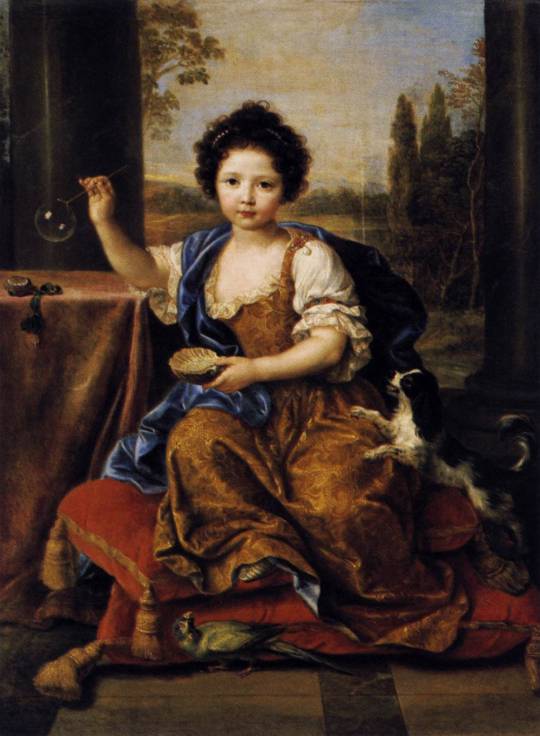
"Louise-Marie de Bourbon, dite Mademoiselle de Tours; La fillette aux bulles de savon"
By Pierre Mignard
Oil Painting, 1681.
Château de Versailles.



PORTRAIT SUBJECT
La fillette aux bulles de savon, or the commonly found English title, Girl Blowing Soap Bubbles, is a portrait of innocence during the Franco-Dutch War.
The child shown is Louise-Marie de Bourbon, the daughter of the Sun King, Louis XIV, and his Maîtresse-en-titre, Françoise-Athénaïs de Rochechouart (Madame de Montespan). I'm sorry, I don't know why they popped off with the names like that when they're planning to reuse Marie and Louis fifty times over ptdr. Louise-Marie, affectionately known as Toutou, was an illegitimate birth (1674), later legitimized by her father when she was around two years old. She held the title of Mademoiselle de Tours from then until her untimely death in 1681.
According to sources, Mignard's painting of the six-year-old girl was finished posthumously. But, her innocence is held delicately, frozen in time on canvas.

THEMES OF CHILDHOOD INNOCENCE (TL;DR: YAPANESE)
Mignard's choice to paint Louise-Marie as an actual child was uncommon for the time (even centuries later, believe it or not; maybe not so good examples, but for argument-sake: Louis XV by Hyacinthe Rigaud, Mariana Victoria of Spain by Nicolas de Largillierre, Phillip II, Duke of Orléans, Reagent of France by Largillierre, and Élisabeth Charlotte d'Orléans, "Mademoiselle de Chartres" by Largillierre -- apologies for throwing you strays, man, I'm trying to finish writing this and your children portraits were on the same website next to each other x), as young royalty are painted either as babies (unbreeched/baptize gown) or as tiny adults (fixed in uncomfortable poses and wearing clothes a monarch would), no in between. Here, Louise-Marie is playing with bubbles, her dog jumping towards it, and she looks carefree, still with chubby cheeks of rose. It doesn't help much that children were seen as heirs to the family fortune, especially during a time when parents had multiple kids due to illness (premature death) and bringing in income (need I explain more... *cough cough* coal mines... a bit anachronistic, sorry breaker boys, some other time we'll discuss y'all).
A painting such as this one, showing a realistic human experience from a royal status and that of a child BEING a child, innocence still intact, is quite important, even in today's form. We take childhood for granted, and kids are forced to grow up despite having more rights now than before. It can be a portrait to remind us that innocence is vital (a lack of childhood is detrimental as the experience is needed in order to mature mentally and emotionally when entering the teen and adult stages of life), but also that we as humans weren't so different from back then (sure, you can claim we bathe more than they do despite your husband still not washing his ass, but my heavens, did the thought 'wait, they had bubbles back then' ever occur to you?).
Genuinely, I was going to pull a La Muse Verte (the post where I briefly explained the history of absinthe) and go into the history of bubbles... because you gotta admit, that'd be fun for the both of us. However, delving into the background and theme of this painting became more heartbreaking for me. The bubble idea isn't gone, but it'll be postponed as a full history lesson post (and, yes, Mignard's painting of the immortalized Toutou will be recycled).

FURTHER READING (EXTRA SYMBOLISTIC DETAIL)
Plenty more symbolism is present, but I highly recommend you all check out L'Art en Tête's in-depth article on Mignard's beautiful portrait. I did regurgitate some of the author's points in this because I thought they were brilliant, and you can tell they have an art-history degree, so I'm begging you to go over there for more detail if interested!

#art#painting#oil painting#artwork#history#french#french art#17th century#1600s#1600s art#late 1600s#17th century art#baroque#Pierre Mignard#Château de Versailles#versailles#Royalty#French history#louis xiv#sun king#symbolism#louise-marie#mademoiselle#art history#house of bourbon#early modern period#kingdom of france
6 notes
·
View notes
Photo

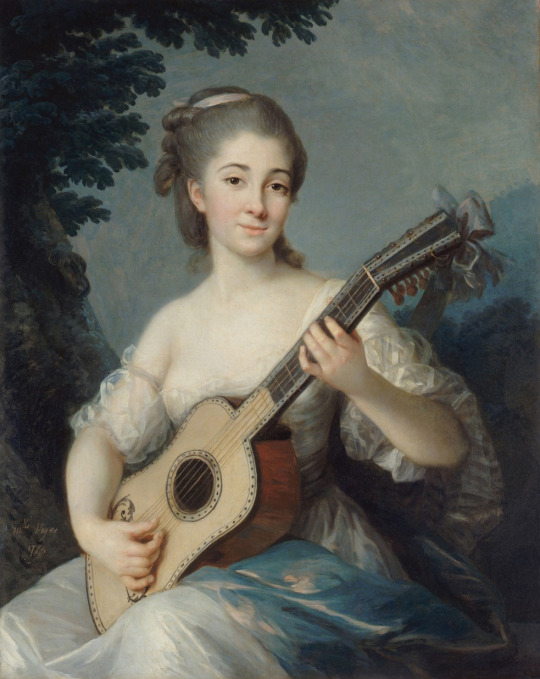


1770s dresses (from top to bottom) -
ca. 1770 Young Woman in an Elegant Interior attributed to Strickland Lowry (Huntington Library, Art Museum, and Botanical Gardens - San Marino, California, USA), From tumblr.com/nellielcvetts/702005685477670912/history-of-fashion-ab-1770-attributed-to. Enlarged by half 796X1200 @72 249kj.
1774 Marie-Louise de Robien by Élisabeth-Louise Vigée-Lebrun (Musée Cognacq-Jay - Paris, France). From tumblr.com/sims4rococo76; fixed obvious spots w Pshop 983X1236 A72 412kj.
1777 Jeune musicienne by Élisabeth-Louise Vigée-Lebrun (location ?). From tumblr.com/sims4rococo76 1080X1196 @72 165kj.
Marie-Anne Révérend by Antoine Vestier (location ?). From tumblr.com/sims4rococo76 766X1000 @72 384kj.
#1770s fashion#Louis XV fashion#Louis XVI fashion#Rococo fashion#cap#U neckline#bows en échelle#V waistline#lace cuffs#ruching#Marie-Louise de Robien#Élisabeth-Louise Vigée-Lebrun#large curl coiffure#hair ribbon#hair feathers#chemise#modesty piece#Marie-Anne Révérend#Antoine Vestier#high coiffure#robe à la circasienne
22 notes
·
View notes
Note
Are there any notable royal twins from history?
Alexander Helios and Cleopatra Selene II
James II of Scotland and Alexander Stewart, Duke of Rothesay
Princess Louise Élisabeth of France and Princess Henriette of France
Princess Aisha and Princess Sara bint Al Faisal
Prince Jean and Princess Margaretha of Luxembourg
Prince Vincent and Princess Josephine of Denmark
Victoire de Valois and Jeanne de Valois
Princess Katharine Amalie Christiane Luise and Caroline of Baden
Elisabeth Ludovika of Bavaria and Princess Amalie Auguste of Bavaria
Princess Gabriella, Countess of Carladès and Jacques, Hereditary Prince of Monaco
56 notes
·
View notes
Text
World building and theories of Engage

Queen Eve
Her name is a reference to Saint Eve. The symbolic relevance of being named after Saint Eve is that she is mother of all the living and Queen Eve is a mother to her children and her kingdom. Saint Eve is more than the wife of Adam and the beguiler of men. She is her own woman, intelligent, brave, rational and caring. Queen Eve demonstrates similar bravery when she is held hostage by Zephia's minion. Her rational and intelligent nature is implied by her ability to convince King Morion to sign a nonaggression pact. Saint Eve's main flaw was her vanity, perhaps this symbolises Firene's flaw, a country focused on aesthetical beauty rather than practical things.
Saint Eve is the patron saint of tailors and gardeners which fits in nicely with Queen Eve being the ruler of 'flower land'.
Saint Eve is blamed for the downfall of man, making him experience pain and mortality. In Engage the two Queens survive while King Morion and King Hyacinth meet their end. I wonder if her name is a cheeky hint at the fall of the two kings.
The dress of the Firenze royal is inspired by French Rococo, a style without any rules. The characteristics of rococo are pastel tone silks, heavily layered skirts, ornate decorative elements such as jewels, ribbons, ruffles and flowers, excessive flamboyance and asymmetric details.
The shade of blue of Queen Eve's dress reminds me of Marie Antoinette, whose favourite colour was light blue. The green ribbon of Queen Eve's dress could be the colour of royalty. When Marie Antoinette wore green it was to impose her regel status.
When I first looked at Queen Eve I was reminded of the infamous painting of Marie Antoinette in the Chemise Dress, holding a rose. In 1783, portrait artist, Élisabeth Louise Vigée Le Brun painted a portrait in what was called robe de gaulle. The dress was sheer, loose, and white with a cinched waist. Technically she was wearing undergarments and this caused a scandal so the painting was redone with her in a pale blue dress. I wonder if Queen Eve caused a similar scandal with her clothing. The flamboyant clothing of Queen Eve is a way of showing wealth and status. Peasants prefered simpler, practical designs.
In the bible green means fertility and fruitfulness which is abundant in Firene. Queen Eve's green ribbon symbolises the fertility of her kingdom and her royal status.
The specific shade of blue symbolises the blue angel light. In the bible Michael is the archangel who commands this light. The light represents bravery, safety, immortality and faith that good would triumph over evil. The white in her dress symbolises purity.
The Crown of Firene is inspired by The fleur de lis diamond royal crown tiara created for Charles X, King of France and worn by Marie Antoinette. It is green to represent royalty, nature and fertility and decorated with white flowers. Rococo ladies often wore flowers in their hair. The fleur de lis shade in front is also a symbol of royalty. At the back of the crown is a variant of the Cross of Lorraine, in freemasonry it is a symbol of religion, hope and faith.
5 notes
·
View notes
Text

Élisabeth Louise Vigée Le Brun (1755–1842), Portrait of Joseph Hyacinthe François-de-Paule de Rigaud, comte de Vaudreuil (1740–1817), ca. 1784. Oil on canvas, 51 x 38 in. Gift of The Ahmanson Foundation. The Huntington Library, Art Museum, and Botanical Gardens.
SAN MARINO, CALIF.- The Huntington Library, Art Museum, and Botanical Gardens has acquired a major painting by Élisabeth Louise Vigée Le Brun (1755–1842), the most important female artist of 18th-century France. Portrait of Joseph Hyacinthe François-de-Paule de Rigaud, comte de Vaudreuil (ca. 1784) is the second masterpiece to come to The Huntington through a gift from The Ahmanson Foundation.
“We are enormously grateful to The Ahmanson Foundation for making this acquisition possible,” Huntington President Karen R. Lawrence said. “Adding an important work by Vigée Le Brun helps us achieve one of our goals—adding more works by important women. Once again, The Ahmanson Foundation proves to be an invaluable strategic partner, allowing us to make a masterpiece accessible to Southern California audiences.”
Courtesy Alain Truong
5 notes
·
View notes
Text
Holidays 4.16
Holidays
Anemone Day (French Republic)
Battle of Culloden Day (UK)
Charlie Chaplin Day
Day of the Badger (Wisconsin)
Dronningens Fodelsdag (Denmark)
Emancipation Day (DC)
Flat Stomach Appreciation Day
Foursquare Day
Frühjahrsbierfest begins (modern festival) [thru 5.8]
Good Deeds Day
International 4p-/Wolf-Hirschhorn Syndrome Awareness Day
Jimmy Buffet Day (Florida)
Jim Thorpe Day
Jose de Diego Day (Puerto Rico)
Lawyers’ Day (Bulgaria)
Liberating the Rainbow Lost in White Light Festival
Memorial Day for the Victims of the Holocaust (Hungary)
Militiamen Day (Cuba)
National Advance Care Planning Day (Canada)
National Angel Day
National Auctioneers Day
National Bean Counters’ Day
National Cash Day
National Clean Out Your Medicine Cabinet Day
National CPA's Goof-Off Day [Day after Tax Day]
National Healthcare Decisions Day
National Horny Day
National Joseph Day
National Librarian Day
National OK Day
National Orchid Day
National Reveal the Genius Within Day
National Selena Day
National Slip-On Shoes Day
National Stress Awareness Day
National Wear Your Pajamas To Work Day
Orkney Day
Police Day (Armenia)
Queen Margrethe II Day (Denmark)
Remembrance of the Chemical Attack on Balisan and Sheikh Was (Iraqi Kurdistan)
Royalty Day
Save the Elephant Day
Teach Your Daughter to Volunteer Day
Totoro Day
Vadai Day (India)
World Day of Entrepreneurship
World Entrepreneurship Day
World Semicolon Day
World Shoes by Flora Day (Nigeria)
World Voice Day
Food & Drink Celebrations
Brown Sugar Day
Dagwood Sandwich Day
Day of Mushroom Encouragement (a.k.a. Day of the Mushroom)
Eggs Benedict Day
Mushroom Day
National Baked Ham with Pineapple Day
National Eggs Benedict Day
Raw-Milk Cheese Appreciation Day
3rd Tuesday in April
Transportation Tuesday [3rd Tuesday]
Weekly Holidays beginning April 16 (3rd Week)
National Oral, Head, and Neck Cancer Awareness Week [thru 4.22]
Independence & Related Days
Cyrillic Federal Republic (Declared; 2022) [unrecognized]
Festivals Beginning April 16, 2024
Cartagena Film Festival (Cartagena, Colombia) [thru 4.21]
Charlotte Wine and Food Week (Charlotte, North Carolina) [thru 4.21]
Cheese Expo (Madison, Wisconsin) [thru 4.18]
Food + Beverage Environmental Conference (Miramar, Florida) [thru 4.19]
Grifton Shad Festival (Grafton, North Carolina) [thru 4.20]
South Bohemian International Beer Festival (Zlatá Pivni Pečet; České Budějovice, Czech Republic) [thru 4.20]
Feast Days
All Hookers’ Day (Church of the SubGenius)
Anatole France (Writerism)
Baby Natasha (Muppetism)
Benedict Joseph Labre (Christian; Saint)
Bernadette Soubirous of Lourdes (Christian; Saint)
Bundling Day (Celtic Book of Days)
Contardo (Christian; Saint)
Days of Mushroom Encouragement (Shamanism)
Dimon (Christian; Saint)
Drogo (Christian; Saint)
Élisabeth-Louise Vigée-Le Brun (Artology)
Encratis (Christian; Martyr & Virgin)
Feast of the Divine Mercy
Ford Madox Brown (Artology)
Fructuosus of Braga (Christian; Saint)
Hiketeria (Festival to Apollo; Ancient Greece; Everyday Wicca)
Holiday of Ra (Ancient Egypt)
Iduna’s Blot (Pagan)
Isabella Gilmore (Church of England)
Joachim of Sienna (Christian; Saint)
Joseph Labre (Christian; Saint)
Kingsley Amis (Writerism)
Magnus of Orkney (Christian; Saint)
Martyrs of Zaragoza (a.k.a. 18 Martyrs of Saragossa; Christian)
Messalina Day (Church of the SubGenius; Saint)
Miss Corner (Muppetism)
Molly Brant (Konwatsijayenni) (Anglican Church of Canada, Episcopal Church)
Offering to Demeter Khloe (Goddess of Green Shoots; Ancient Greece)
Optatos and Companions (Christian; Martyrs)
Padarn (Christian; Saint)
Paternus (Christian; Saint)
Ridvan begins (Baha’i)
Sapho, by Charles Gounod (Opera; 1851)
Sea Monkey Soup Day (Pastafarian)
Spring Cleaning Day (Starza Pagan Book of Days)
Turibius of Astorga (Christian; Saint)
Varro (Positivist; Saint)
Lucky & Unlucky Days
Butsumetsu (仏滅 Japan) [Unlucky all day.]
Fortunate Day (Pagan) [15 of 53]
Tycho Brahe Unlucky Day (Scandinavia) [16 of 37]
Very Unlucky Day (Grafton’s Manual of 1565) [21 of 60]
Premieres
Antboy (Film; 2014)
Benny & Joon (Film; 1993)
The Best and the Brightest, by David Halberstam (Book; 1973)
Book of the Month Club (Bookselling Subscription; 1926)
Brown Sugar, by The Rolling Stones (Song; 1971)
Bug Carnival (Terrytoons Cartoon; 1937)
Bulletproof Monk (Film; 2003)
Daddy Duck (Disney Cartoon; 1948)
Death at a Funeral (Film; 2010)
Detective Conan: The Scarlet Bullet (Anime Film; 2021)
Everybody Loves Somebody, recorded by Dean Martin (Song; 1964)
Everything Is Illuminated, by Jonathan Safron Foer (Novel; 2002)
Fibber McGee and Molly (Radio Series; 1935)
The Foolish Bunny (Color Rhapsody; 1938)
The Ginger Bread Boy (Oswald the Lucky Rabbit Cartoon; 1934)
Goopy Geer (WB MM Cartoon; 1932)
Hair Today Gone Tomorrow (Noveltoons Cartoon; 1959)
The Hole Idea (WB LT Cartoon; 1955)
Horrible Histories (TV Series; 2009)
Hospitaliky (Fleischer Popeye Cartoon; 1937)
The House That Jack Built (Color Rhapsody; 1939)
It Don’t Come Easy, by Ringo Starr (Song; 1971)
James Paul McCartney, by Paul McCartney (TV Special; 1973)
Kill Bill: Vol. 2 (Film; 2004)
Kiss-Ass (Film; 2010)
Le Prophète, by Giacomo Meyerbeer (Opera; 1849)
Life During Wartime (Film; 1998)
Love & Basketball (Film; 2000)
A Mighty Wind (Film; 2003)
Mother Goose Melodies (Silly Symphony Cartoon; 1931)
The Music Box (Short Film; 1932)
My Neighbor Totoro (Studio Ghibli Animated Film; 1988)
The Organization Man, by William H. Whyte Jr. (Book; 1957)
Porky’s Five & Ten (WB LT Cartoon; 1938)
Poultry Pirates (MGM Cartoon; 1938)
The Punisher (Film; 2004)
The Rolling Stones, by The Rolling Stones (Album; 1964)
Romeo and Juliet (Terrytoons Cartoon; 1933)
The Sound of the Mountain, by Yasunari Kawabata (Novel; 1954)
The Spy Who Loved Me, by Ian Fleming (Novel; 1959) [James Bond #10]
Spy x Family (Anime TV Series; 2022)
The Sunlight Dialogues, by John Gardner (Novel; 1973)
Temple of the Dog, by Temple of the Dog (Album; 1991)
This Land is Your Land, recorded by Woody Guthrie (Song; 1944)
The White Princess (TV Series; 2017)
Wide Sargasso Sea (Film; 1993)
Zooey, by J.D. Salinger (Novella; 1957) [Collected in Franny & Zooey in 1961]
Today’s Name Days
Bernadette, Magnus (Austria)
Velichka, Velichko, Velin, Velina (Bulgaria)
Bernardica, Leonida (Croatia)
Irena (Czech Republic)
Mariane (Denmark)
Olivia, Olve, Olvi (Estonia)
Jalo, Patrik (Finland)
Benoît-Joseph, Rameaux (France)
Bernadette, Joachim, Magnus (Germany)
Anastasios, Calis, Galini, Galinos, Hionia, Lambros, Niki, Paschalis (Greece)
Csongor (Hungary)
Bernadette, Giuditta, Grazia, Lamberto, Maria (Italy)
Alfs, Mindaugs, Mintauts (Latvia)
Algedė, Gražvydas, Kalikstas (Lithuania)
Magnus, Mons (Norway)
Benedykt, Bernadetta, Cecyl, Cecylian, Charyzjusz, Erwin, Erwina, Julia, Ksenia, Lambert, Lamberta, Nikita, Nosisław, Patrycy, Urban (Poland)
Agapi, Hionia, Irina (Romania)
Dana, Danica (Slovakia)
Engracia, Fructuoso, Toribio (Spain)
Patricia, Patrik (Sweden)
Irene, Oryna, Orysia (Ukraine)
Kareem, Magnus, Malvin, Malvina, Melva, Melvin, Melvina (USA)
Today is Also…
Day of Year: Day 107 of 2024; 259 days remaining in the year
ISO: Day 2 of week 16 of 2024
Celtic Tree Calendar: Saille (Willow) [Day 3 of 28]
Chinese: Month 3 (Wu-Chen), Day 8 (Getg-Xu)
Chinese Year of the: Dragon 4722 (until January 29, 2025) [Wu-Chen]
Hebrew: 7 Nisan 5784
Islamic: 7 Shawwal 1445
J Cal: 17 Cyan; Threesday [17 of 30]
Julian: 3 April 2024
Moon: 58%: Waxing Gibbous
Positivist: 23 Archimedes (4th Month) [Columella]
Runic Half Month: Man (Human Being) [Day 7 of 15]
Season: Spring (Day 29 of 92)
Week: 3rd Week of April
Zodiac: Aries (Day 27 of 31)
0 notes
Text
Expansion of the royal domain
The way in which the kingdom was ruled in its different provinces had always varied according to the degree that power had been permanently or temporarily devolved to apanage princes and great nobles or that representative assemblies continued to function. It is therefore axiomatic that there was no 'system of government' in the France of the Renaissance. The question is: was there a tendency for the kingdom to become more centralised? R. Bonney has wisely cautioned against the over-use in French history of the term 'centralisation', a term coined in 1794. The main distinction drawn in the early modern period, as Mousnier made clear, was that between the king's 'delegated' and 'retained' justice, the latter covering all the public affairs of the kingdom in which the crown was supreme and the former the private affairs of his subjects. No one would pretend, however, that a clear line of division was ever established between the two.
If we consider the case of the apanages and' great fiefs, for instance, the century from the reign of Louis XI is usually considered definitive in their suppression. In 1480, there were around 80 great fiefs. By 1530 around half of these still existed. The rest were in abeyance or held by members of the royal family. Within the royal house, the apanage of Orleans was reunited to the crown on the accession of Louis XII, although thereafter used periodically for the endowment of the king's younger son, permanently so after the reign of Louis XIV. The complex of territories held by the Bourbon and Bourbon-Montpensier families fell by the treason of the Constable in 1523. Burgundy (and temporarily Artois and Franche-Comté) were taken over in 1477. Among the great fiefs, the county of Comminges was united to the crown on the death of count Mathieu de Foix in 1453, the domains of the Armagnacs (such as the county of Rodez) were confiscated on the destruction of Jean V at Lectoure in 1473. They found their way by the reign of Francis I into the hands of the royal family, through the marriage of Jean V's sister to the count of Alençon. The last Alençon duke, Charles, married Francis I's sister, Marguerite of Angoulême, and Alençon's sister, Françoise, married duke Charles of Vendôme, grandfather of Henry IV. Brittany was acquired through war and marriage alliance in the 1490s, Provence and the domains of the house of Anjou after the death of king René and then of Charles d'Anjou in 1481. The archives of the Chambre des comptes of Anjou for the early 1480s give ample evidence of the king's determination to exploit his new acquisition as soon as possible.
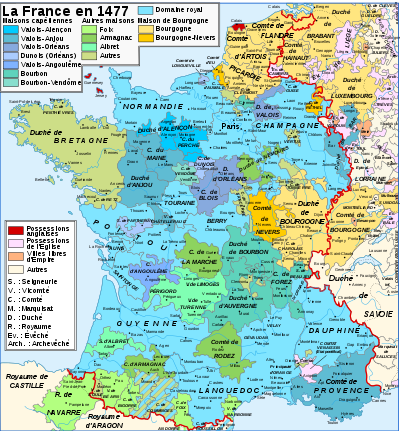
It should not be assumed that the crown pursued a consistent determination to lay hands on all these territories and rule them directly. There was usually a more or less lengthy period of adjustment to a new status. Some apanages and territories taken over by Louis XI were absorbed into the general administration of the rest of the kingdom. This was clearly the case with Burgundy and Picardy-Artois in 1477, both of them in the area under the jurisdiction of the Parlement of Paris. Yet even here, Louis XI had to tread warily in winning over the support of the regional nobility and discontent was apt to break out until the end of the fifteenth century. On Louis's death, for instance, a rising occurred in Picardy at Bertrancourt near Doullens, with cries of 'there is no longer a king in France, long live Burgundy!' The absorption of Artois proved to be an impossible undertaking and had to be renounced in 1493.
Elsewhere, absorption of apanages that were distant from the centre of royal power left affairs locally much as they had been before. The little Pyreneen county of Comminges was governed much as it had been under its counts, with privileges confirmed by Charles VIII in 1496. Only with the work of royal commissioners in the tax-assessing process in the 1540s, the first time an outside power had actively intervened in the affairs of the local nobility, did this begin to change. Auvergne, an apanage raised to a duchy in 1360, was confirmed to the Bourbons in 1425 on condition that their whole domain became an apanage. The duchy was confiscated from the Constable in 1523 but transferred by the king to his mother in 1527 and only absorbed into the royal domain in 1531. Even after that, it formed the dower of Charles IX's queen and then part of the apanage of François d'Anjou, his brother. In the contiguous county of Forez, also confiscated in 1523, little local opposition emerged to the change of regime; although the local chambre des comptes was shortly suppressed, most local judicial officials, along with the entire administrative structure, were retained. Except for a few partisans of the Constable, it seems that there was no great upheaval. Louise de Bourbon, the Constable's sister and princess of La Roche-sur-Yon, demanded a share of the inheritance - Forez, Beaujolais and Dombes. Beaujolais and the principality of Dombes eventually went to Louise's son, Montpensier.
The county of Auvergne, enclaved in the duchy, was held by the duke of Albany in his wife's name, and was then inherited from the last of the La Tour d'Auvergne family by Catherine de Medici. Catherine brought it to the crown by her marriage with Henri II in 1533 but she continued to administer it as her own property. She left it to Charles IX's bastard, Charles de Valois, but her daughter Marguerite made good her claim to it in 1606 and it only entered the royal domain definitively when she willed it to Louis XIII.
After her marriage to Charles VIII in 1491, Brittany was administered as her own property by queen Anne, technically still duchess but in reality sharply circumscribed in her power, until her husband's death restored some of her freedom of action in 1498. Having already established friendly relations with Louis XII when he was still duke of Orleans, she was prepared to accept his offer of marriage after the annulment of his marriage to Louis Xl's daughter, Jeanne, had been agreed. The contract which accompanied the marriage in January 1499 tied the duchy to the crown provisionally on condition that it always passed to the second son of the marriage, while in the absence of issue the duchy was to revert to Anne's heirs on her own side. Anne was able to act rather more independently during her marriage to Louis XII though the conditions of the contract were not observed. On her death Brittany was inherited by her elder daughter Claude, wife of Francis I, who transmitted her rights to her son the dauphin. The queen had, however, transferred the government of the duchy to her husband in 1515 and he continued to rule it in the name of his son François on Claude's death, entitling acts as 'legitime administrateur et usufructuaire' of his son's property. When the dauphin's majority in 1532 brought the question of the imminent personal union of the duchy to the kingdom to the foreground, it was arranged for the Breton estates to 'request' full union with France but on terms which guaranteed Breton privileges and maintained the principle that the dauphin would be duke of Brittany. Only in 1536, on the death of the dauphin, was the union with the kingdom complete and no more dukes were crowned at Rennes. What had been done was the annulment of the Breton succession law, which included females, in favour of the French royal succession law. Late in 1539, it was decided that the new dauphin Henri would have the government of Brittany 'to govern as he pleases', though the documents were delayed by the king's illness. A 'Declaration' transferring Brittany to Henri was drawn up in 1540. In practice, the government of the duchy seems not to have been much changed.
The lands of the house of France-Anjou posed a complex problem. René of Anjou, titular king of Jerusalem, Sicily, Aragon and Naples, was count of Provence in his own right, of Maine and Anjou as apanagiste and Guise by succession. As early as 1478, Louis was scheming to ensure that king René, who had no surviving son, did not leave his territories of Anjou, Provence and Bar to his grandson, René II of Lorraine, warning the general of Languedoc that his region would be 'destroyed' if Provence fell into other hands. On the 'good' king's death in 1480, most of his domains passed to his cousin Charles IV d'Anjou, count of Maine, who died childless in 1481, when Maine and Anjou reverted to the crown, thereafter to be granted out to members of the royal family such as Louise of Savoy. At the same time Provence was acquired by Louis XI by Charles IV's will and the county of Guise was disputed between the houses of Armagnac-Nemours, Lorraine (heirs of René I of Anjou and successors as titular kings of Jerusalem and Sicily) and Pierre de Rohan, marshal de Gié. From 1481, however, the king ruled in Provence as 'count of Provence and Forcalquier'. The lord of Soliès, Palamède de Forbin, who had persuaded Charles d'Anjou to leave the county to the king, was rewarded with the post of governor. The major change came in 1535 with the edicts of Joinville and Is-sur-Tille on the government of Provence, limiting the scope of the old institutions of the Estates and the Sénéchal and increasing that of the Parlement of Aix in justice and of the royal governor in administration. Curiously, Francis I was reported as having said that he felt an obligation to 'ceux de Guise', the house of Lorraine in France, since Louis XI had despoiled them of their inheritance of Provence and Anjou.
The major surviving complex of apanage lands by the middle of the sixteenth century was that held by Antoine de Bourbon, now first prince of the blood and next in line to the throne after the immediate royal family, and his wife Jeanne d'Albret. These involved a group of territories held by different tenures. The Albret inheritance brought the titular kingship of Navarre with a small fragment of the ancient kingdom of Navarre north of the Pyrénées that was held in sovereignty. In the counties of Foix, Albret and Béarn, the family held effective sway under only the most distant royal sovereignty, though Louis XI saw fit to pose as the protector of the young François-Phébus in 1472. In 1476, he sought to revise local tariffs against Albret interests and in 1480 attempts to levy a taille for the gendarmerie there stirred up a rebellion. In western France, the duchy of Vendôme, erected as late as 1515 to detach it from dependence on the duchy of Anjou, was held as an apanage under rather closer royal supervision. In the north, the complex of lands administered from La Fère-sur-Oise and centring the county of Marle was held directly of the king or of the Habsburg ruler of the Netherlands, rendering the family, to some, unreliable. Practical power stemmed from the holding of the governorships of Picardy and of Guyenne by the Bourbons and Henri d'Albret.
Other independent territories persisted, such as the vicomté of Turenne, where the vicomte (of the La Tour d'Auvergne family) ruled with regalian rights until the eighteenth century, could raise taxes, coin money, make war and render justice as a limited monarch in conjunction with very active local estates.
David Potter - A History of France, 1460-1560- The Emergence of a Nation State
#xv#xvi#david potter#a history of france 1460 1560: the emergence of a nation state#louis xi#louis xii#charles iii de bourbon#mathieu de foix#jean v d'armagnac#françois i#charles iv d'alençon#marguerite d'angoulême#rené d'anjou#charles viii#charles ix#élisabeth d'autriche#louise de bourbon#gilbert de montpensier#catherine de medici#house of la tour d'auvergne#charles de valois#louis xiii#anne de bretagne#jeanne de france#claude de france#charles iv d'anjou#louise de savoie#house of guise#capetian house of bourbon#antoine de bourbon
4 notes
·
View notes
Text
Holidays 4.16
Holidays
Anemone Day (French Republic)
Battle of Culloden Day (UK)
Charlie Chaplin Day
Day of the Badger (Wisconsin)
Dronningens Fodelsdag (Denmark)
Emancipation Day (DC)
Flat Stomach Appreciation Day
Foursquare Day
Frühjahrsbierfest begins (modern festival) [thru 5.8]
Good Deeds Day
International 4p-/Wolf-Hirschhorn Syndrome Awareness Day
Jimmy Buffet Day (Florida)
Jim Thorpe Day
Jose de Diego Day (Puerto Rico)
Lawyers’ Day (Bulgaria)
Liberating the Rainbow Lost in White Light Festival
Memorial Day for the Victims of the Holocaust (Hungary)
Militiamen Day (Cuba)
National Advance Care Planning Day (Canada)
National Angel Day
National Auctioneers Day
National Bean Counters’ Day
National Cash Day
National Clean Out Your Medicine Cabinet Day
National CPA's Goof-Off Day [Day after Tax Day]
National Healthcare Decisions Day
National Horny Day
National Joseph Day
National Librarian Day
National OK Day
National Orchid Day
National Reveal the Genius Within Day
National Selena Day
National Slip-On Shoes Day
National Stress Awareness Day
National Wear Your Pajamas To Work Day
Orkney Day
Police Day (Armenia)
Queen Margrethe II Day (Denmark)
Remembrance of the Chemical Attack on Balisan and Sheikh Was (Iraqi Kurdistan)
Royalty Day
Save the Elephant Day
Teach Your Daughter to Volunteer Day
Totoro Day
Vadai Day (India)
World Day of Entrepreneurship
World Entrepreneurship Day
World Semicolon Day
World Shoes by Flora Day (Nigeria)
World Voice Day
Food & Drink Celebrations
Brown Sugar Day
Dagwood Sandwich Day
Day of Mushroom Encouragement (a.k.a. Day of the Mushroom)
Eggs Benedict Day
Mushroom Day
National Baked Ham with Pineapple Day
National Eggs Benedict Day
Raw-Milk Cheese Appreciation Day
3rd Tuesday in April
Transportation Tuesday [3rd Tuesday]
Weekly Holidays beginning April 16 (3rd Week)
National Oral, Head, and Neck Cancer Awareness Week [thru 4.22]
Independence & Related Days
Cyrillic Federal Republic (Declared; 2022) [unrecognized]
Festivals Beginning April 16, 2024
Cartagena Film Festival (Cartagena, Colombia) [thru 4.21]
Charlotte Wine and Food Week (Charlotte, North Carolina) [thru 4.21]
Cheese Expo (Madison, Wisconsin) [thru 4.18]
Food + Beverage Environmental Conference (Miramar, Florida) [thru 4.19]
Grifton Shad Festival (Grafton, North Carolina) [thru 4.20]
South Bohemian International Beer Festival (Zlatá Pivni Pečet; České Budějovice, Czech Republic) [thru 4.20]
Feast Days
All Hookers’ Day (Church of the SubGenius)
Anatole France (Writerism)
Baby Natasha (Muppetism)
Benedict Joseph Labre (Christian; Saint)
Bernadette Soubirous of Lourdes (Christian; Saint)
Bundling Day (Celtic Book of Days)
Contardo (Christian; Saint)
Days of Mushroom Encouragement (Shamanism)
Dimon (Christian; Saint)
Drogo (Christian; Saint)
Élisabeth-Louise Vigée-Le Brun (Artology)
Encratis (Christian; Martyr & Virgin)
Feast of the Divine Mercy
Ford Madox Brown (Artology)
Fructuosus of Braga (Christian; Saint)
Hiketeria (Festival to Apollo; Ancient Greece; Everyday Wicca)
Holiday of Ra (Ancient Egypt)
Iduna’s Blot (Pagan)
Isabella Gilmore (Church of England)
Joachim of Sienna (Christian; Saint)
Joseph Labre (Christian; Saint)
Kingsley Amis (Writerism)
Magnus of Orkney (Christian; Saint)
Martyrs of Zaragoza (a.k.a. 18 Martyrs of Saragossa; Christian)
Messalina Day (Church of the SubGenius; Saint)
Miss Corner (Muppetism)
Molly Brant (Konwatsijayenni) (Anglican Church of Canada, Episcopal Church)
Offering to Demeter Khloe (Goddess of Green Shoots; Ancient Greece)
Optatos and Companions (Christian; Martyrs)
Padarn (Christian; Saint)
Paternus (Christian; Saint)
Ridvan begins (Baha’i)
Sapho, by Charles Gounod (Opera; 1851)
Sea Monkey Soup Day (Pastafarian)
Spring Cleaning Day (Starza Pagan Book of Days)
Turibius of Astorga (Christian; Saint)
Varro (Positivist; Saint)
Lucky & Unlucky Days
Butsumetsu (仏滅 Japan) [Unlucky all day.]
Fortunate Day (Pagan) [15 of 53]
Tycho Brahe Unlucky Day (Scandinavia) [16 of 37]
Very Unlucky Day (Grafton’s Manual of 1565) [21 of 60]
Premieres
Antboy (Film; 2014)
Benny & Joon (Film; 1993)
The Best and the Brightest, by David Halberstam (Book; 1973)
Book of the Month Club (Bookselling Subscription; 1926)
Brown Sugar, by The Rolling Stones (Song; 1971)
Bug Carnival (Terrytoons Cartoon; 1937)
Bulletproof Monk (Film; 2003)
Daddy Duck (Disney Cartoon; 1948)
Death at a Funeral (Film; 2010)
Detective Conan: The Scarlet Bullet (Anime Film; 2021)
Everybody Loves Somebody, recorded by Dean Martin (Song; 1964)
Everything Is Illuminated, by Jonathan Safron Foer (Novel; 2002)
Fibber McGee and Molly (Radio Series; 1935)
The Foolish Bunny (Color Rhapsody; 1938)
The Ginger Bread Boy (Oswald the Lucky Rabbit Cartoon; 1934)
Goopy Geer (WB MM Cartoon; 1932)
Hair Today Gone Tomorrow (Noveltoons Cartoon; 1959)
The Hole Idea (WB LT Cartoon; 1955)
Horrible Histories (TV Series; 2009)
Hospitaliky (Fleischer Popeye Cartoon; 1937)
The House That Jack Built (Color Rhapsody; 1939)
It Don’t Come Easy, by Ringo Starr (Song; 1971)
James Paul McCartney, by Paul McCartney (TV Special; 1973)
Kill Bill: Vol. 2 (Film; 2004)
Kiss-Ass (Film; 2010)
Le Prophète, by Giacomo Meyerbeer (Opera; 1849)
Life During Wartime (Film; 1998)
Love & Basketball (Film; 2000)
A Mighty Wind (Film; 2003)
Mother Goose Melodies (Silly Symphony Cartoon; 1931)
The Music Box (Short Film; 1932)
My Neighbor Totoro (Studio Ghibli Animated Film; 1988)
The Organization Man, by William H. Whyte Jr. (Book; 1957)
Porky’s Five & Ten (WB LT Cartoon; 1938)
Poultry Pirates (MGM Cartoon; 1938)
The Punisher (Film; 2004)
The Rolling Stones, by The Rolling Stones (Album; 1964)
Romeo and Juliet (Terrytoons Cartoon; 1933)
The Sound of the Mountain, by Yasunari Kawabata (Novel; 1954)
The Spy Who Loved Me, by Ian Fleming (Novel; 1959) [James Bond #10]
Spy x Family (Anime TV Series; 2022)
The Sunlight Dialogues, by John Gardner (Novel; 1973)
Temple of the Dog, by Temple of the Dog (Album; 1991)
This Land is Your Land, recorded by Woody Guthrie (Song; 1944)
The White Princess (TV Series; 2017)
Wide Sargasso Sea (Film; 1993)
Zooey, by J.D. Salinger (Novella; 1957) [Collected in Franny & Zooey in 1961]
Today’s Name Days
Bernadette, Magnus (Austria)
Velichka, Velichko, Velin, Velina (Bulgaria)
Bernardica, Leonida (Croatia)
Irena (Czech Republic)
Mariane (Denmark)
Olivia, Olve, Olvi (Estonia)
Jalo, Patrik (Finland)
Benoît-Joseph, Rameaux (France)
Bernadette, Joachim, Magnus (Germany)
Anastasios, Calis, Galini, Galinos, Hionia, Lambros, Niki, Paschalis (Greece)
Csongor (Hungary)
Bernadette, Giuditta, Grazia, Lamberto, Maria (Italy)
Alfs, Mindaugs, Mintauts (Latvia)
Algedė, Gražvydas, Kalikstas (Lithuania)
Magnus, Mons (Norway)
Benedykt, Bernadetta, Cecyl, Cecylian, Charyzjusz, Erwin, Erwina, Julia, Ksenia, Lambert, Lamberta, Nikita, Nosisław, Patrycy, Urban (Poland)
Agapi, Hionia, Irina (Romania)
Dana, Danica (Slovakia)
Engracia, Fructuoso, Toribio (Spain)
Patricia, Patrik (Sweden)
Irene, Oryna, Orysia (Ukraine)
Kareem, Magnus, Malvin, Malvina, Melva, Melvin, Melvina (USA)
Today is Also…
Day of Year: Day 107 of 2024; 259 days remaining in the year
ISO: Day 2 of week 16 of 2024
Celtic Tree Calendar: Saille (Willow) [Day 3 of 28]
Chinese: Month 3 (Wu-Chen), Day 8 (Getg-Xu)
Chinese Year of the: Dragon 4722 (until January 29, 2025) [Wu-Chen]
Hebrew: 7 Nisan 5784
Islamic: 7 Shawwal 1445
J Cal: 17 Cyan; Threesday [17 of 30]
Julian: 3 April 2024
Moon: 58%: Waxing Gibbous
Positivist: 23 Archimedes (4th Month) [Columella]
Runic Half Month: Man (Human Being) [Day 7 of 15]
Season: Spring (Day 29 of 92)
Week: 3rd Week of April
Zodiac: Aries (Day 27 of 31)
0 notes
Text
Marie Antoinette: The Last Queen of France and Her Controversial Legacy
On 10th May, Louis XVI of France and his wife, the Austrian princess Marie Antoinette, began their reign. The young princess became the queen consort of France, a position that many desired. Marie Antoinette had a beautiful face and a graceful manner, and everyone was curious about what kind of queen she would be: a supporter of the arts, a subtle diplomat, a political counselor to her husband, a devout wife and queen? She ended up being all of these things – and more.

Archduchess Maria Antonia of Austria, the later Queen Marie Antoinette of France by Joseph Ducreux {PD}
She left a lasting impression on French history unlike any other French consort. Marie Antoinette was a talented musician – she played the harp and the harpsichord, and learned from Gluck in her childhood – as well as a singer and a fan of composers such as André Grétry. Marie Antoinette was also passionate about fashion and liked to invent new dresses and hairstyles, breaking with tradition and making the work of her ladies-in-waiting harder than usual.

Marie Antoinette playing the harp at the French Court by Jean-Baptiste André Gautier-Dagoty {PD}
She enjoyed being daring – sculptures like this show her lively personality and extravagant style.
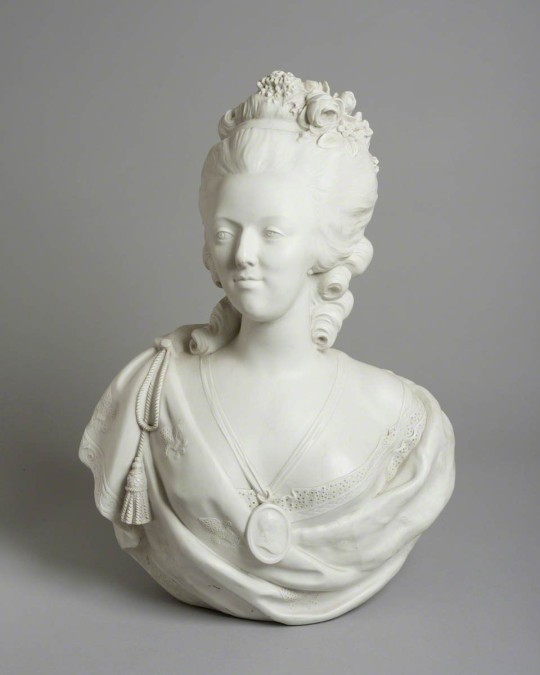
Marie Antoinette by Jean-Antoine Houdon, photo credit: Grundy Art Gallery, licensed under CC BY-NC-SA
Despite her great impact on the arts, Marie Antoinette was often regarded as the puppet of her mother, the Holy Roman Empress Maria Theresa – she was often attacked at the French court and called 'The Austrian' by her enemies. She soon became a scapegoat both at court and outside and, while she was initially loved by the French people, her lavishness during a hard economic time quickly turned this love into resentment. The more she tried to advise her husband in politics, the stronger the accusations against her became. She was vilified in pamphlets and libels, and her bad reputation affected her husband's as well.
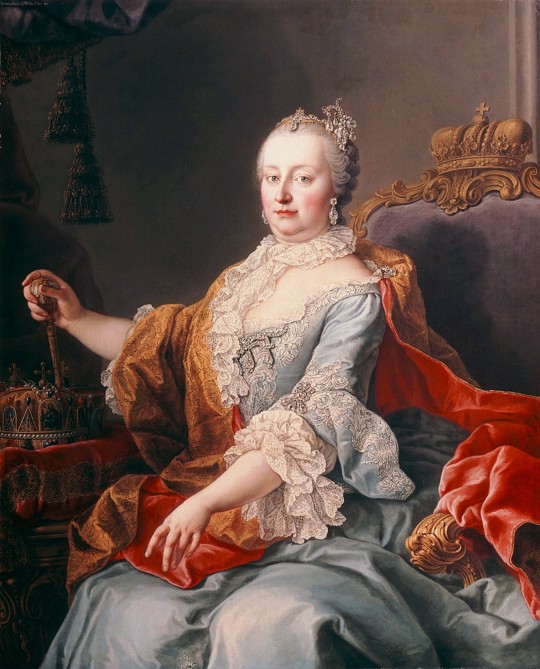
Empress Maria Theresia of Austria by Martin van Meytens {PD}
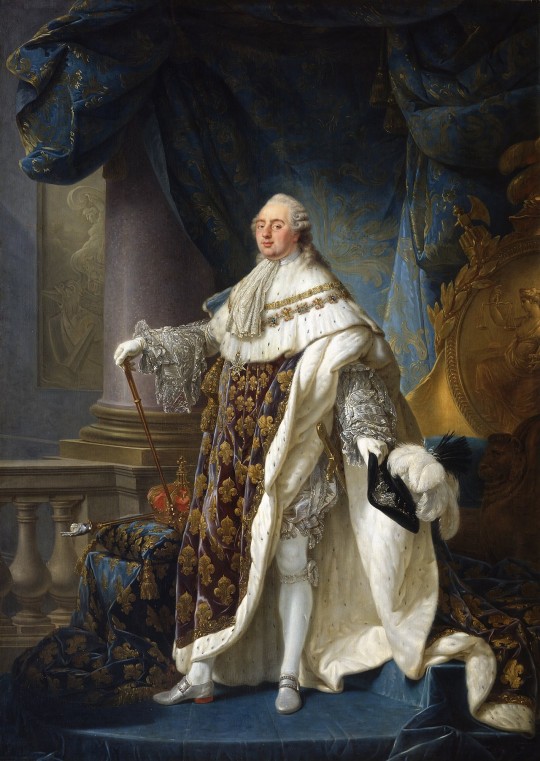
Louis XVI, King of France and Navarre, wearing his grand royal costume in 1779 by Antoine-François Callet {PD}
When the French Revolution started in 1789, Marie's mixed feelings about the situation caused a lot of damage to the French monarchy. She was advised by her family in Austria to escape, but she was conflicted between her willingness to compromise and her fears of the people's intentions. The royal family decided to flee, which led to the end of the monarchy in France.

The Royal Family of France in the Prison of the Temple by Edward Ward
Louis XVI was tried for treason and eventually executed on 21st January 1793. His reign will always be remembered by his failure to preserve the monarchy and the Bourbon dynasty, and will always be linked to the French Revolution.
As for Marie Antoinette – who, as the consort of France, was supposed to have a wonderful destiny and future – her final moments were far from glamorous. She was imprisoned with her children and her ladies-in-waiting, and she was eventually tried for treason and executed on 16th October 1793, at the age of only 37.
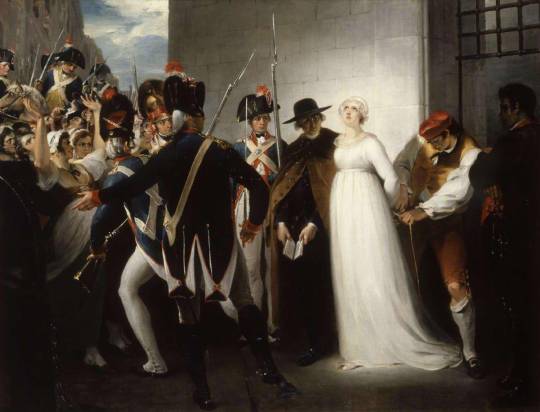
Marie Antoinette being taken to her Execution by William Hamilton {PD}
Her death caused outrage in the rest of Europe as most of her siblings were ruling other countries and realms. Her sister, Maria Carolina of Naples, swore to avenge her, developing a pure hatred against France for what they did. From an Austrian princess to a French queen consort, no one could have foreseen Marie Antoinette's terrible fate.
Marie Antoinette wrote to her sister-in-law, Madame Elisabeth, in her final moments. She had a close and sincere friendship with her over the years.

Elisabeth-Philippe-Marie-Hélène de France, dite Madame Elisabeth by Élisabeth Louise Vigée Le Brun {PD}
Her only thoughts were for her children, whom she wanted to protect desperately, even after her death. 'I am very saddened to leave my poor children; you know that they and you, my kind and loving sister, were my only reason to live.'
She advised, 'Let them both remember what I have always taught them, that virtuous principles and the faithful performance of every duty, are the first foundation of life; that their happiness will depend on their mutual love and trust.' She finished her letter with what she wanted her legacy to be: 'Let them never seek to avenge our death.' It was for her wise words and her maternal love that Marie Antoinette wanted her children to remember her.
Sadly, all her children died young except for Marie-Thérèse, who became the Duchess of Angoulême.

Queen Marie Antoinette of France and two of her Children (Marie-Thérèse Charlotte and Louis Joseph) Walking in The Park of Trianon by Adolf Ulrik Wertmüller (Nationalmuseum (Photo: Erik Cornelius)) {PD}

Portrait of Maria Theresia Charlotte of Bourbon by Heinrich Füger {PD}
Even today, especially in France, Marie Antoinette is a controversial figure. She is remembered for betraying France and for being the source of all its troubles, but her legacy is more complex, as her last letter shows. In the end, Marie Antoinette had her flaws, of course, but she also remained a loyal mother who was separated from her children and who tried to leave them a legacy of peace and love – if only through her words.
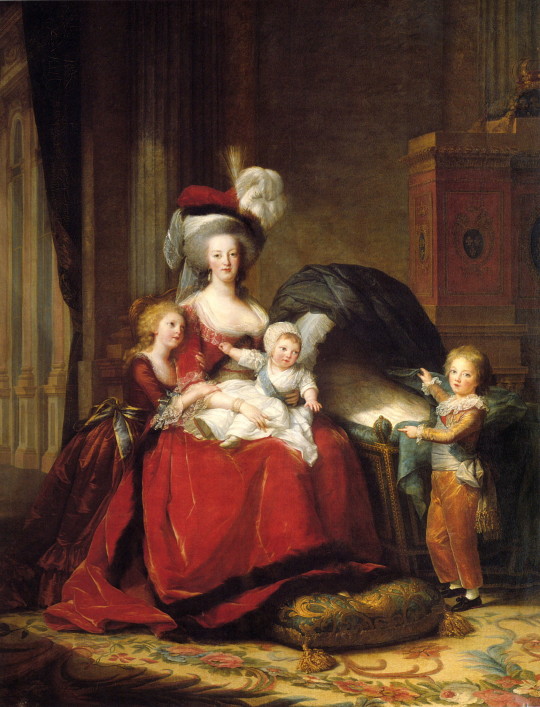
Marie-Antoinette de Lorraine-Habsbourg, Queen of France, and her children by Élisabeth Louise Vigée Le Brun {PD}
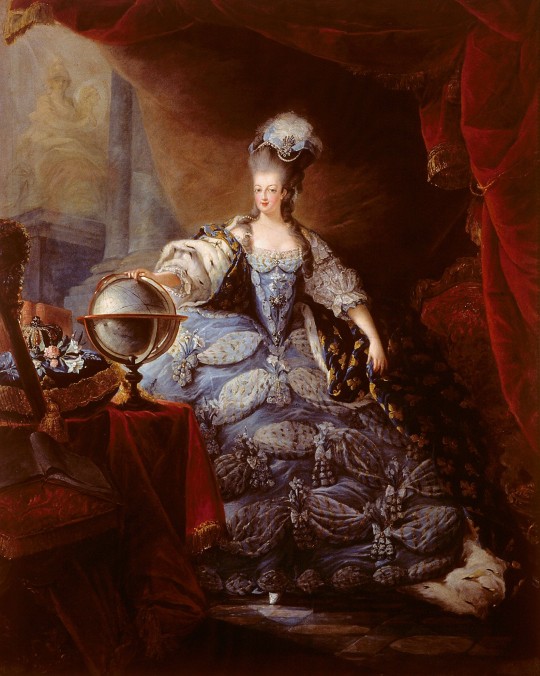
Portrait of Marie-Antoinette of Austria by Jean-Baptiste André Gautier-Dagoty {PD}


Marie Antoinette, Queen of France, in a court dress by François Hubert Drouais {PD}
#art#artwork#art history#artist#paint#drawing#marie antoinette#french revolution#kinglouis#classicart#queen of france#france#court#monarchy#exile#18th century#austria#monarch#history#geschichte#kunst
1 note
·
View note
Text
My Writings and Contributions
Translations of Frev Sources
Media and books influenced by Thermidorian propaganda
Here are some facts we take for granted that revolutionaries didn't know that will blow your mind
Learning to Be a Lawyer in 18thc France
Brief historiography on women, the law, marriage and divorce (scroll down)
Brief overview of the Thermidorian Reaction
On Saint-Just's Personality: An Introduction
Saint-Just in Five (Long) Sentences
Random Sources and References on Saint-Just's Youth (In French)
Louise Michel's Poem on Saint-Just
On Charles Le Bas, Philippe's brother and Élisabeth Duplay's second husband
References on Couthon
Book and article recommendations:
The "short" version
Part 1 - A Note On Objectivity and Two Approaches (introduction) + Culture: Enlightenment and Antiquity
Part 2 - Ideological Stakes
Part 3 - Old Classics and Syntheses
Part 4 - Specific Topics and Areas of Research
Part 5 - Side-related but still important
Part 6 - Highlights and Short Reviews
My Posts In Progress and Eventual Research:
My thoughts and analysis of Saint-Just's unsent letter to Villain d’Aubigny
A (brief?) introduction to Saint-Just’s many faces and myths
Could Saint-Just have been neurodivergent?
Why Enjolras was inspired by Saint-Just: comparing the text of the brick to Saint-Just’s Romantic Myth
An Episode of the Thermidorian Reaction: the Attack on the Club des Jacobins and the Misogynist Targetting of Women
How the pamphlet about the Club infernal locates them in the circle of Wrath and not Treason - the latter would out them as counterrevolutionaries
Can we call the French Revolution a "fandom"? The invention of celebrity culture, etc.
The differences between Thermidorian propaganda and Anglo-American propaganda (and where they overlap)
Other Important Posts
Some primary and secondary sources available online for free (by anotherhumaninthisworld; some additions by myself)
Frev Resources (by iadorepigeons)
Myths and misconceptions about the French Revolution
Anglo American historiography (by saintjustitude and dykespierre)
On the Terror's Death Toll and Donald Greer (by montagnarde1793) More about this topic here and here (by lanterne, anotherhumaninthisworld, frevandrest and radiospierre)
On Robespierre's Black Legend (by rbzpr)
On Thermidorian propaganda (by lanterne)
On Couthon (by iadorepigeons)
Marat Ressource Masterpost (by orpheusmori)
Collaborative Masterpost on Saint-Just (many authors)
Saint-Just Masterpost (by obscurehistoricalinterests)
One myth on Saint-Just (by saintjustitude and frandrest)
Saint-Just as political philosopher and theorist (by saintjustitude)
Élisabeth Lebas corrects Alphonse de Lamartine’s Histoire des Girondins (1847) (by anotherhumaninthisworld)
On Charlotte Robespierre's memoirs (by montagnarde1793 and saintjustitude)
On Simonne Évrard (French and English biography copy-pasted by saintjustitude from the ARBR website)
Regulations for the internal exercises of the College of Louis-le-Grand (by anotherhumaninthisworld)
Were Robespierre and Desmoulins together at Louis-le-Grand? (by robespapier and anotherhumaninthisworld)
Robespierre was not Horace Desmoulins' godfather (by robespapier and anotherhumaninthisworld)
The relationship of Camille Desmoulins and Robespierre in literary works of Przybyszewska (by edgysaintjust)
Last edited: 16/05/2023
Support me!
220 notes
·
View notes